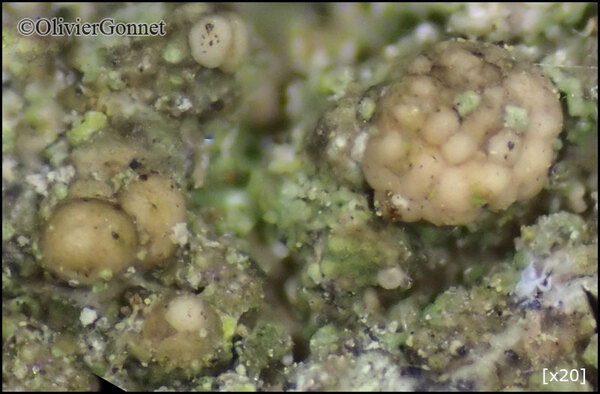Bacidina phacodes (Körb.) Vězda
Folia Geobot. Phytotaxon., 25: 432, 1991. Basionym: Bacidia phacodes Körb. - Parerga Lichenol.: 130, 1860.
Synonyms: Bacidia albescens (Stizenb.) Bausch; Bacidia chlorotica (Nyl.) Sandst. non sensu Th. Fr.; Lecidea chlorotica (Rostr.) Hue
Distribution: N - Frl (TSB 2798), TAA (Nascimbene 2014, Nimis & al. 2015, Nascimbene & al. 2022), Lig. C - Tosc (Tretiach & Nimis 1994, Benesperi 2011), Marc (Nimis & Tretiach 1999), Laz (Bartoli & al. 1997), Sar (Llop 2002, Zedda 2002, Cossu 2013). S - Camp (Aprile & al. 2002, 2003, 2003b, Nimis & Tretiach 2004, Garofalo & al. 2010, Ravera & Brunialti 2013, Catalano & al. 2016), Pugl (Nimis & Tretiach 1999, Durini & Medagli 2004), Bas (Bartoli & Puntillo 1998, Nimis & Tretiach 1999, Potenza & al. 2010), Cal (Puntillo 1996), Si (Nimis & al. 1994, 1996b, Ravera & al. 2023b).
Description: Thallus crustose, white to grey-green, thin to irregularly warted or scurfy, but without goniocysts. Apothecia biatorine, 0.2-0.5 mm across, sessile, often confluent and appearing tuberculate, whitish, cream-coloured to pale orange-brown when dry, translucent when wet, with a flat to strongly convex disc, and a usually paler, soon excluded proper margin. Proper exciple > 6 cells thick, colourless, of radiating hyphae; epithecium colourless or pale brownish yellow, scarcely differentiated from the hymenium; hymenium mostly colourless, 35-50 μm high (30–40% of the total apothecium height), I+ blue, then reddish brown; paraphyses simple, 1-1.5 μm thick at mid-level, the apical cells sometimes clavate and to 3 μm wide; hypothecium colourless. Asci 8-spored, clavate to cylindrical-clavate, the apical dome K/I+ dark blue with a pale, conical-pointed apical cushion (axial mass) never penetrating through the entire d-layer, the wall K/I-, but the thin outer gel K/I+ blue, Bacidia-type. Ascospores 3-7-septate, hyaline, acicular but often gradually tapering at one end, often curved, (20-)25-35(-45) x 1.5-2 μm. Pycnidia rather rare, immersed, the walls colourless. Conidia thread-like, 3-7-septate, straight, (24-)28-50(-60) x 1-1.5(-2) μm. Photobiont chlorococcoid, the cells 7-10 μm in diam. Spot tests: thallus and apothecia K-, C-, KC-, P-, UV-. Chemistry: thallus without lichen substances.Note: a mild-temperate to humid subtropical lichen found on bark of broad-leaved trees, more rarely on rock, often on dry undersides of thick branches of ancient trees; in the Mediterranean belt confined to humid evergreen forests, sometimes on silicicolous mosses.
Growth form: Crustose
Substrata: bark and lignum
Photobiont: green algae other than Trentepohlia
Reproductive strategy: mainly sexual
Most common in areas with a humid-warm climate (e.g. most of Tyrrenian Italy)
In underhangs rarely wetted by rain
Commonnes-rarity: (info)
Alpine belt: absent
Subalpine belt: extremely rare
Oromediterranean belt: absent
Montane belt: very rare
Submediterranean belt: extremely rare
Padanian area: absent
Humid submediterranean belt: rare
Humid mediterranean belt: very rare
Dry mediterranean belt: absent

Predictive model
Herbarium samples
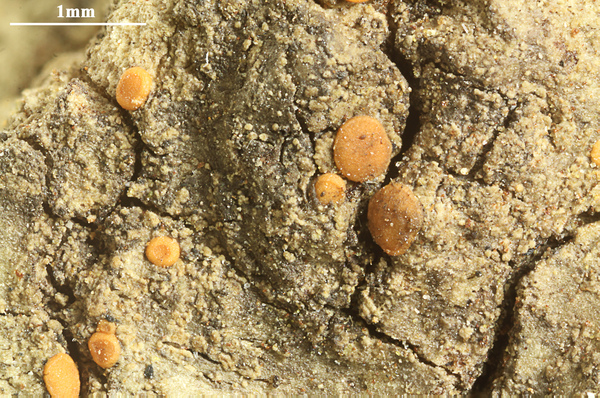

Felix Schumm - CC BY-SA 4.0
[20568], U.S.A. California, Monterey County, on Umbellularia californica, floor of canyon at Big Sur. Leg. W. A. Weber & R. Santesson, 2.4.1966. LICHENES EXSICCATI DISTRIBUTED BY THE UNIVERSITY OF COLORADO MUSEUM, BOULDER NO. 182 [as Bacidia albescens (Arn.) Zwackh.]
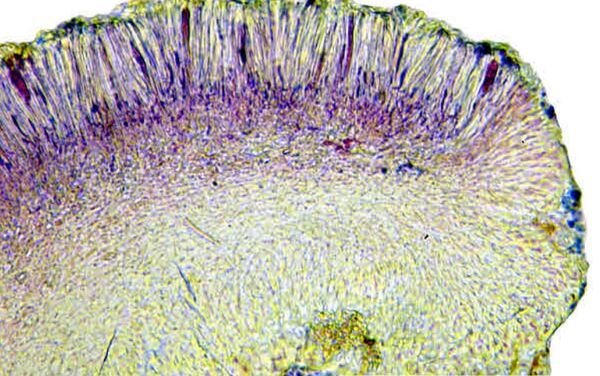

Felix Schumm – CC BY-SA 4.0
[13625], Germany, Baden-Württemberg, Kreis Göppingen, südwestlich von Adelberg nahe dem Herrenbachstausee, Buhwiesenweg, an Laubbaum im Mischwald, ca. 48°44'N, 9°33'E, 412 m, ZK 7223. Leg. Schumm 08.02.2008, det. Schumm 2008
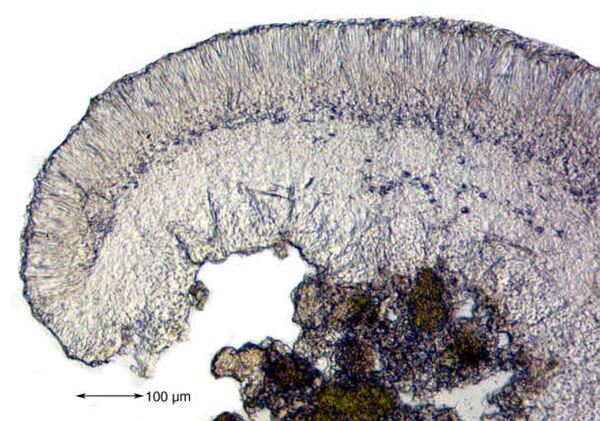

Felix Schumm – CC BY-SA 4.0
[13625], Germany, Baden-Württemberg, Kreis Göppingen, südwestlich von Adelberg nahe dem Herrenbachstausee, Buhwiesenweg, an Laubbaum im Mischwald, ca. 48°44'N, 9°33'E, 412 m, ZK 7223. Leg. Schumm 08.02.2008, det. Schumm 2008
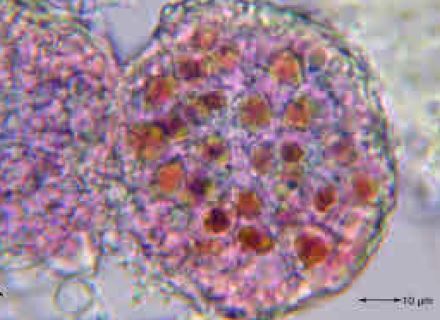

Felix Schumm – CC BY-SA 4.0
[13625], Germany, Baden-Württemberg, Kreis Göppingen, südwestlich von Adelberg nahe dem Herrenbachstausee, Buhwiesenweg, an Laubbaum im Mischwald, ca. 48°44'N, 9°33'E, 412 m, ZK 7223. Leg. Schumm 08.02.2008, det. Schumm 2008


Felix Schumm – CC BY-SA 4.0
[13625], Germany, Baden-Württemberg, Kreis Göppingen, südwestlich von Adelberg nahe dem Herrenbachstausee, Buhwiesenweg, an Laubbaum im Mischwald, ca. 48°44'N, 9°33'E, 412 m, ZK 7223. Leg. Schumm 08.02.2008, det. Schumm 2008
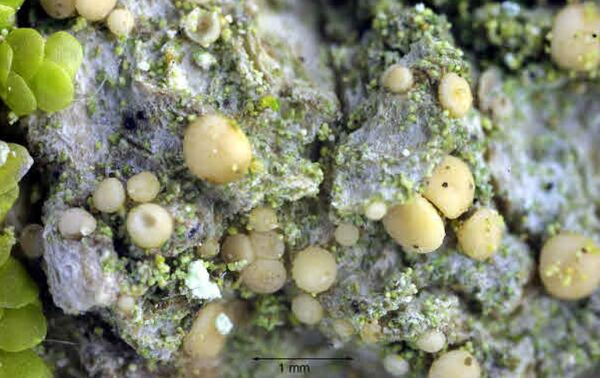

Felix Schumm – CC BY-SA 4.0
[13625], Germany, Baden-Württemberg, Kreis Göppingen, südwestlich von Adelberg nahe dem Herrenbachstausee, Buhwiesenweg, an Laubbaum im Mischwald, ca. 48°44'N, 9°33'E, 412 m, ZK 7223. Leg. Schumm 08.02.2008, det. Schumm 2008
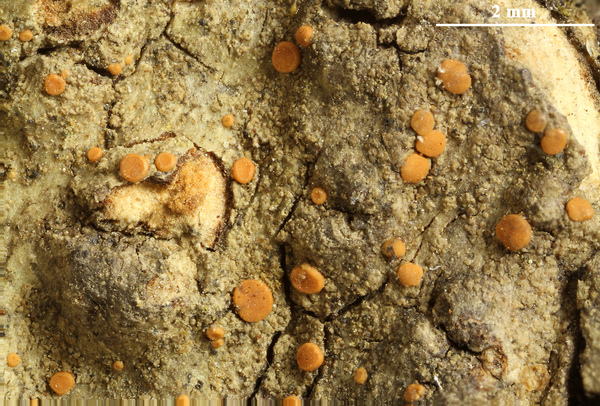

Felix Schumm - CC BY-SA 4.0
[20568], U.S.A. California, Monterey County, on Umbellularia californica, floor of canyon at Big Sur. Leg. W. A. Weber & R. Santesson, 2.4.1966. LICHENES EXSICCATI DISTRIBUTED BY THE UNIVERSITY OF COLORADO MUSEUM, BOULDER NO. 182 [as Bacidia albescens (Arn.) Zwackh.]
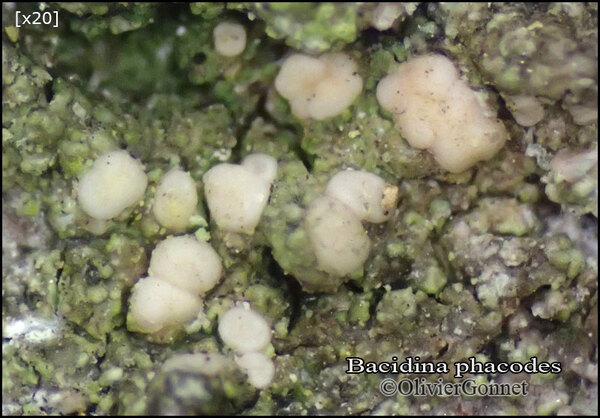
Courtesy: Olivier et Danièle Gonnet - Source: https://www.afl-lichenologie.fr/Photos_AFL/Photos_AFL_B/Bacidina_phacodes.htm
France, session AFL 2015 - Blanzaguet - Lot
Growth form: Crustose
Substrata: bark and lignum
Photobiont: green algae other than Trentepohlia
Reproductive strategy: mainly sexual
Most common in areas with a humid-warm climate (e.g. most of Tyrrenian Italy)
In underhangs rarely wetted by rain
Commonnes-rarity: (info)
Alpine belt: absent
Subalpine belt: extremely rare
Oromediterranean belt: absent
Montane belt: very rare
Submediterranean belt: extremely rare
Padanian area: absent
Humid submediterranean belt: rare
Humid mediterranean belt: very rare
Dry mediterranean belt: absent

Predictive model
| Herbarium samples |


Felix Schumm - CC BY-SA 4.0
[20568], U.S.A. California, Monterey County, on Umbellularia californica, floor of canyon at Big Sur. Leg. W. A. Weber & R. Santesson, 2.4.1966. LICHENES EXSICCATI DISTRIBUTED BY THE UNIVERSITY OF COLORADO MUSEUM, BOULDER NO. 182 [as Bacidia albescens (Arn.) Zwackh.]


Felix Schumm – CC BY-SA 4.0
[13625], Germany, Baden-Württemberg, Kreis Göppingen, südwestlich von Adelberg nahe dem Herrenbachstausee, Buhwiesenweg, an Laubbaum im Mischwald, ca. 48°44'N, 9°33'E, 412 m, ZK 7223. Leg. Schumm 08.02.2008, det. Schumm 2008


Felix Schumm – CC BY-SA 4.0
[13625], Germany, Baden-Württemberg, Kreis Göppingen, südwestlich von Adelberg nahe dem Herrenbachstausee, Buhwiesenweg, an Laubbaum im Mischwald, ca. 48°44'N, 9°33'E, 412 m, ZK 7223. Leg. Schumm 08.02.2008, det. Schumm 2008


Felix Schumm – CC BY-SA 4.0
[13625], Germany, Baden-Württemberg, Kreis Göppingen, südwestlich von Adelberg nahe dem Herrenbachstausee, Buhwiesenweg, an Laubbaum im Mischwald, ca. 48°44'N, 9°33'E, 412 m, ZK 7223. Leg. Schumm 08.02.2008, det. Schumm 2008


Felix Schumm – CC BY-SA 4.0
[13625], Germany, Baden-Württemberg, Kreis Göppingen, südwestlich von Adelberg nahe dem Herrenbachstausee, Buhwiesenweg, an Laubbaum im Mischwald, ca. 48°44'N, 9°33'E, 412 m, ZK 7223. Leg. Schumm 08.02.2008, det. Schumm 2008


Felix Schumm – CC BY-SA 4.0
[13625], Germany, Baden-Württemberg, Kreis Göppingen, südwestlich von Adelberg nahe dem Herrenbachstausee, Buhwiesenweg, an Laubbaum im Mischwald, ca. 48°44'N, 9°33'E, 412 m, ZK 7223. Leg. Schumm 08.02.2008, det. Schumm 2008


Felix Schumm - CC BY-SA 4.0
[20568], U.S.A. California, Monterey County, on Umbellularia californica, floor of canyon at Big Sur. Leg. W. A. Weber & R. Santesson, 2.4.1966. LICHENES EXSICCATI DISTRIBUTED BY THE UNIVERSITY OF COLORADO MUSEUM, BOULDER NO. 182 [as Bacidia albescens (Arn.) Zwackh.]

 Index Fungorum
Index Fungorum
 GBIF
GBIF
